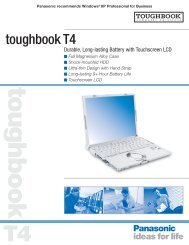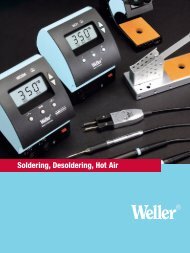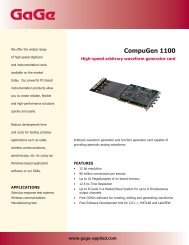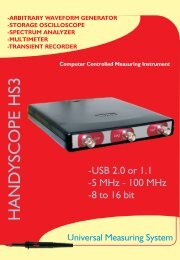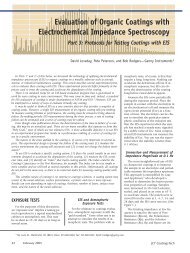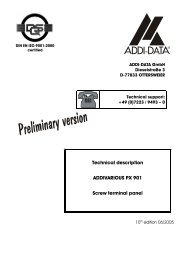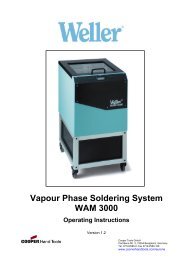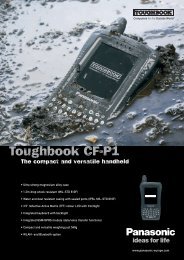CompuScope SDK Manua.. - Egmont Instruments
CompuScope SDK Manua.. - Egmont Instruments
CompuScope SDK Manua.. - Egmont Instruments
You also want an ePaper? Increase the reach of your titles
YUMPU automatically turns print PDFs into web optimized ePapers that Google loves.
<strong>CompuScope</strong> RepetitiveCapture PerformanceSince <strong>CompuScope</strong> cards are installed directly on the PCI or CompactPCI bus, their on-board acquisitionmemory can be accessed directly through this bus, without having to go through a GPIB or RS-232interface. This direct access allows data transfer rates that are hundreds of times faster than those of GPIBor RS-232. Fast data throughput is one of the key advantages of the PC-based <strong>CompuScope</strong> over thetraditional stand-alone oscilloscope interfaced to a PC through a GPIB or RS-232 interface.Applications that require fast data throughput are generally those in which the user must capture recordsthat occur at a high Pulse Repeat Frequency (PRF). Working in <strong>CompuScope</strong> Single Record mode, theuser must be able to transfer the data from <strong>CompuScope</strong> acquisition memory to PC RAM and re-arm the<strong>CompuScope</strong> in time to be ready for the next trigger. If the data throughput is not fast enough, then the<strong>CompuScope</strong> will not be prepared for the next trigger and the trigger will be missed.One application that makes use of the high data throughput of <strong>CompuScope</strong> cards is radar signal processingor any other application which requires short bursts of data to be captured at very high repeat frequencies.A typical example is a radar system which requires capture of 64 point bursts at least a few thousand timesa second. This application requires development of a custom <strong>CompuScope</strong> Windows application. This isvery easy using the example C programs provided by the <strong>CompuScope</strong> <strong>SDK</strong>.While the performance of a <strong>CompuScope</strong> card is deterministic in single-tasking operating systems such asMS DOS, its performance is not deterministic under MS Windows – a non-Real-Time multi-taskingoperating system. The uncertainty arises because of the indeterminate time during which a Windowsprocess may be ”put to sleep” while Windows services other processes. In a Real-Time Operating System(RTOS), such as QNX or RealTime Linux, the operating system can guarantee a worst case “process sleeptime”. In a non-RTOS like Windows, however, no such worst-case sleep time can be guaranteed.Consequently, even though a <strong>CompuScope</strong> may in theory meet certain transfer speed performancebenchmarks, no such performance can be guaranteed under Windows Practically, performance is heavilydependent on the type of Windows operating system and on system configuration. In addition, furtherreduction in performance occurs due to the overhead of calling Windows Kernel-level driver functionsthrough the Dynamically Linked Library (DLL) from the application or user level. Each subroutine call tothe drivers requires crossing of the user/Kernel boundary, which has an associated boundary crossing timethat is at least a few microseconds. This boundary crossing time is also dependent on the OS and systemconfiguration.Typically, customers who do repetitive signal capture want to know what is the maximum Pulse RepeatFrequency (PRF) that can be achieved for their <strong>CompuScope</strong> card. As discussed, the PRF calculation is100 % reliable only for operation under DOS. Under Windows, due to its non-RealTime nature,deterministic operation cannot be guaranteed. No matter how slow the trigger rate is, the possibility alwaysexists of missing triggers. However, PRF calculations can be used as a reliable guide to determine averagerepetitive capture performance under Windows.The minimum Pulse Repeat Interval (PRI) is equal to the time required to completely handle one triggerand re-arm for the next one. The minimum PRI is equal to the sum of the capture time, which is the timerequired to capture the signal, the transfer time, which is the time required to transfer the signal data from<strong>CompuScope</strong> acquisition memory to PC RAM and the overhead time, which is the time required to re-armthe <strong>CompuScope</strong> for the next acquisition. The minimum PRI increases with the post-trigger depth, theamount of data to be transferred, the number of acquisition channels and the number of Bytes per Sample(1 for 8 bit <strong>CompuScope</strong>s, 2 for <strong>CompuScope</strong>s with more than 8-bit resolution).The capture time calculation is straightforward. The transfer time is determined using the PCI busmasteringtransfer rate. <strong>CompuScope</strong>s can achieve sustained PCI bus-mastering transfer rates of up to 100Page 22<strong>CompuScope</strong> <strong>SDK</strong> <strong>Manua</strong>l



